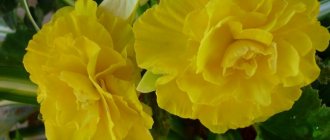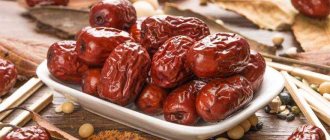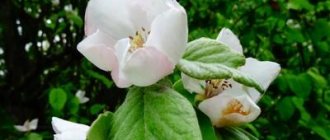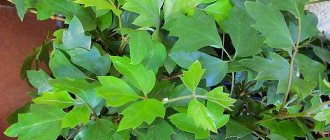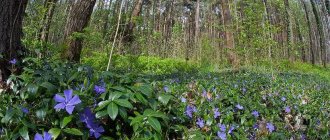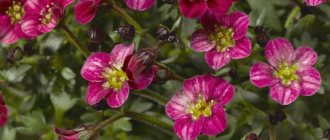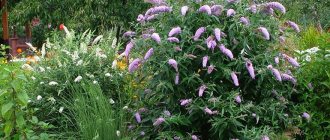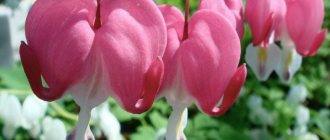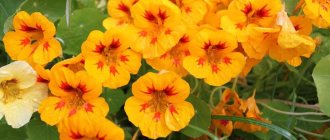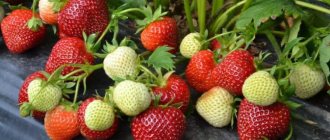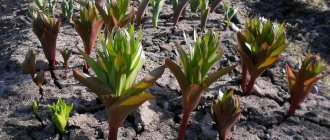Author: Elena N. https://floristics.info/ru/index.php?option=com_contact&view=contact&id=19 Category: Garden plants Published: February 14, 2019Last edits: October 24, 2021
- Growing conditions
- Reproduction by root suckers
- Beneficial features
Japanese Chaenomeles (lat. Chaenomeles japonica), or Japanese quince , is a species of flowering dicotyledonous plants of the Chaenomeles genus of the Rosaceae family. The species is native to Japan, although the plant is also widely grown in China and Europe. The generic name is literally translated from Greek as “split an apple.”
Planting and caring for chaenomeles
- Flowering: abundant, in May-June for three weeks.
- Planting: in spring, before sap flow begins, and in autumn, during leaf fall.
- Lighting: bright sunlight.
- Soil: rich in humus, light – sandy loam, loamy or soddy-podzolic, slightly acidic – pH 6.5.
- Watering: after planting - frequent and plentiful, especially during dry periods. In the future, regular but moderate.
- Fertilizing: after planting, fertilizing will be needed only after a year: in the spring, a bucket of compost, 100 g of potassium fertilizer and 300 g of superphosphate are added to the tree trunk circle. In summer, quince is fertilized with ammonium nitrate or mullein.
- Pruning: sanitary cleaning and formative pruning are carried out in early spring, before sap flow begins. When the bush reaches eight to ten years of age, it undergoes anti-aging pruning.
- Reproduction: seeds, root suckers, grafting and cuttings.
- Pests: scale insects and spider mites.
- Diseases: cytosporosis and ramulariasis.
Read more about growing Chaenomeles below.
Botanical description
Japanese quince chaenomeles is a densely leafy shrub up to 3 m high with a dense crown of the same diameter. Young shoots of the plant are green, scaly-felt, then they become bare and black-brown. The leaves of Japanese quince are spatulate or obovate, narrowed towards the base, with blunt-toothed edges, 3 to 5 cm long and 2 to 3 cm wide. When young they are bronze, but the mature leaves of the plant are dark green. Pink, scarlet-red or orange flowers up to 5 cm in diameter are collected in 2-6 pieces in corymbose inflorescences. The round-shaped yellow-green edible fruits of Japanese quince with a diameter of up to 6 cm ripen by mid-autumn.
Planting and caring for quince in open ground
The plant has been in cultivation since 1874. The Japanese quince bush grows very slowly. The plant is thermophilic, but despite this it is able to withstand frosts down to -30 ºC, although at this temperature its annual shoots and flower buds that are above the snow level freeze slightly. Therefore, Japanese quince in Siberia may not bloom as luxuriantly as Japanese quince in the Moscow region or Japanese quince in the Urals. However, this crop is grown even in places with harsh climates.
Where can it be grown?
Magnificent quince has fairly good winter hardiness and drought resistance, so it is suitable for cultivation in the southern, central and even northern regions of Russia. However, in this case it is better to cover young plants for the winter.
How is it used?
Magnificent quince is an ornamental shrub that is well suited for decorating areas. With it you can :
- create living thorny hedges;
- arrange borders;
- flower beds, etc.
The bushes lend themselves well to pruning and can take on a beautiful shape. In addition, they can be used for medicinal purposes . They have anti-inflammatory, vascular-strengthening and anti-sclerotic effects. Can be used to prevent colds and flu.
The fruits themselves have many vitamins. They are rich in carotene and microelements. At the same time, they have a specific astringent taste. The fruits are not consumed fresh, because... they are hard and sour. Despite this, they can be grown for processing. They make delicious and aromatic jams, preserves, pastilles, etc.
The fruits have gelling properties and after processing acquire a pleasant taste.
Planting Japanese quince in open ground
When to plant
Planting and caring for Japanese quince follows the general rules for growing garden shrubs. It is better to plant chaenomeles in open ground in the spring, before sap flow begins. Autumn planting of the plant is also possible, but it is less desirable, since the heat-loving chaenomeles may not have time to take root in a new place before the onset of frost. The best planting material is two-year-old Japanese quince seedlings with a closed root system, which are watered abundantly before planting. For seedlings with an open root system, you should carefully examine the roots, if necessary, soak them in water for several hours, and then remove rotten, dry and damaged roots.
- Budleya: growing in the garden, types and varieties
How to plant
Chaenomeles is planted in well-lit areas, since in the shade it develops worse and does not bloom as profusely. The plant prefers soil rich in humus, but light - soddy-podzolic, loamy or sandy loam with a slightly acidic reaction (pH 6.5). Japanese quince tolerates peat soils less well. It is advisable to allocate a place for it, protected from winds and drafts, on the south or southwest side of the house. Keep in mind that Japanese quince does not tolerate transplantation very well, and it will have to grow for 50-60 years in the place you choose.
The soil for spring planting needs to be prepared in the fall: cleared of weeds, dug up with the addition of leaf soil and sand. For digging, peat manure compost is also added at the rate of 10 kg per m² and 40 g of phosphorus and potassium fertilizers per the same unit of area. For a single planting, dig a hole with a diameter of 50 cm and a depth of 50-80 cm, and also prepare a soil mixture by adding 1-2 buckets of humus, 500 g of ash, 300 g of superphosphate and 30 g of potassium nitrate to the fertile soil from the top layer removed when digging the hole. . In group planting, plants are placed at a distance of 80-150 cm from each other, and when planting a hedge, an interval of 50-60 cm is sufficient. If you intend to get a fruit harvest by autumn, then plant 2-3 different varieties nearby. One bush of Japanese quince produces an average of about 2 kg of fruit, but there are also productive years when you can harvest up to 5 kg from one plant.
Planting and caring for an apple tree in the garden
On the day of planting, a mound of soil mixture is poured into the center of the hole and the seedling is placed on it so that the root collar is flush with the surface. The remaining space of the pit is filled with fertile soil mixture. After planting, the surface is compacted and watered abundantly. The shoots of the seedling are shortened to 15-20 cm.
Features: Superior View
Magnificent quince prefers well-lit areas.
It has good drought resistance. Can grow for a long time without watering. Despite this, in the first years after planting the plant, it requires a sufficient amount of moisture.
This variety is considered quite winter-hardy . It can withstand cold weather. Despite this, it is better to cover young bushes for the winter.
Japanese quince care
Growing conditions
Growing and caring for Japanese quince is unlikely to seem like a difficult task. During the first time after planting, quince needs regular watering, this is especially important during dry periods. After watering, the soil around the plant is carefully loosened to a depth of 8-10 cm. At the same time, weeds should be removed. To retain moisture in the soil as long as possible, the trunk circle of Japanese quince, the size of the crown projection, is mulched with a layer of peat, pine nut shells, crushed bark or sawdust 3-5 cm thick.
Once you have applied fertilizer when planting in a hole, the plant will not need it for at least a year. From the second or third year of life, Japanese quince is fed with mineral and organic fertilizers in the spring: a bucket of compost, 300 g of superphosphate and 100 g of potassium fertilizer are poured into the trunk circle of each bush. During the summer, liquid fertilizing with a solution of ammonium nitrate (20 g of fertilizer for each bush) or mullein (3 liters of a ten percent solution for each plant) will not be superfluous.
In late autumn, you need to prepare Japanese quince for winter. The tree trunk circle is securely covered with a thick layer of dry foliage or spruce branches. Seedlings or rooted cuttings are covered with spunbond or lutrasil, and low-growing compact bushes are covered with wooden boxes or cardboard boxes.
Diseases and pests
Japanese quince gets sick in exceptional cases, when there is practically no care for it or under the influence of natural disasters, for example, in cool rainy weather, which provokes the activity of fungal infections, the development of necrosis and spotting. At this time, the plant can be affected by cytosporosis or ramularia: the leaves of the plant become brown, dry, and the color of the Chaenomeles bark changes. These diseases must be controlled with copper-based antifungal chemicals, but diseased branches and shoots must be removed and burned before treatment.
Among the pests for Japanese quince, scale insects and spider mites are dangerous, the appearance of which is easier to prevent than to get rid of them for a long time. The first preventive spraying with an acaricidal drug (Aktara, Aktellik, Karbofos and the like) is carried out before the buds open, and then re-treatment may not be necessary.
Pruning Japanese quince
The Japanese quince shrub tolerates pruning well, and this makes it a most valuable plant for ornamental gardening. To avoid injury, wear thick gardening gloves when pruning.
Planting and caring for pears in the garden
In the spring, sanitary cleaning of the bush is carried out: shoots frozen in winter, dry, damaged and improperly growing are removed. Places of cuts thicker than 7 mm are treated with garden varnish. Formative pruning is also carried out in the spring, before sap flow begins, but the crown of the plant begins to form at the age of four to five: to prevent the bush from growing wider and thickening, part of the root shoots are cut out annually, leaving only 2-3 young offspring. The most valuable are shoots located horizontally at a height of 20-40 cm from the ground. Shoots growing vertically or creeping along the ground must be removed.
When the bush reaches eight to ten years of age and the annual growth of shoots decreases to 10 cm, it is necessary to carry out anti-aging pruning. First, the bush is thinned out, leaving only 10-15 strong shoots. Since the main fruiting occurs on three to four year old branches, you need to gradually cut out branches that are five or more years old, replacing them with young shoots from the root shoots.
Average prices for seedlings
Superba quince seedlings can be purchased at different prices, which depend on the growing region, nursery, age of the plant and the specific variety. For example :
- A seedling of the Elli Mossel variety can be bought for an average of 180 rubles.
- Jet Trail quince can be purchased for 790 rubles per seedling.
- Cameo nurseries offer an average of 641 rubles per seedling.
- Quince Nikolain is offered for 450 rubles.
These are approximate prices, but they can vary greatly depending on the region and the condition of the seedlings.
Reproduction of Chaenomeles
Japanese Chaenomeles propagates by seeds, cuttings, root suckers and grafting.
Reproduction by root suckers
Chaenomeles produces abundant root shoots, due to which the bush gradually grows in width and at the age of twenty occupies an area of about 2 m². You can dig up and plant root suckers 10-15 cm long and about 5 mm thick with well-developed roots. One plant can produce 5-6 such offspring. The planted shoots are regularly watered, and the surface of the soil around the shoots is mulched with shavings, wood chips or humus. The disadvantage of this method of propagation is that the shoots growing from the tap root still have an underdeveloped root system, and they have to be grown.
- Osteospermum: growing from seeds, types and varieties
Growing from seeds
The generative method of propagation of Chaenomeles is the most reliable. Fresh Japanese quince seeds, with a germination rate of about 80%, are sown in the ground before winter, and in the spring they sprout vigorously. Two-year-old seedlings form long tap roots, so they need to be planted in a permanent place as early as possible.
If you were unable to sow the seeds before winter, put them in the refrigerator for stratification, where they will remain in a bag of wet sand for 2-3 months. In the spring, as soon as they hatch, they can be sown in the ground.
Propagation by cuttings
The advantage of propagating Japanese quince by cuttings is that this method preserves the varietal properties of the plant. Green cuttings are cut in dry, hot weather in early June. Each cutting should have 1-2 internodes, and on the lower cut there should be a heel (a piece of last year’s wood) up to 1 cm long. For successful rooting of cuttings, it is necessary to use growth stimulants - indolylbutyric acid or Kornevin. The cuttings are immersed with the lower cut into a substrate consisting of three parts sand and one part peat, at an angle of 45º according to a 7x5 cm pattern and kept under a transparent cap at a temperature of 20-25ºC. The roots of the cuttings grow in 35-40 days, then the cuttings are planted in a permanent place.
Chaenomelis grafting
Japanese quince is grafted in May using the improved copulation method. A varietal cutting is taken as a scion, and a seedling of the main species or other rosaceous crops is used as a rootstock. Eye grafting is carried out in July-August, during the second sap flow: a bud (eye) with a piece of bark (scutellum) is cut off from the middle part of the varietal shoot with a sharp knife. Then a T-shaped cut in the bark is made on the bark of the rootstock, its edges are folded back and a shield with a peephole is inserted under them. Then the bent edges of the bark of the T-shaped cut are pressed against the shield and the scion is tightly tied in this place so that the eye itself is not covered with a bandage. After 3-4 weeks, if you did everything correctly, the eye should take root. If next spring the new bud sprouts, the bandage is removed.
Flowering period and when do the fruits ripen?
Magnificent quince flowers bloom in late April or early June. They appear along with the leaves or even before they appear, depending on the variety.
The shrub can bloom until autumn . The fruits of most varieties appear in October. They ripen in late autumn. In northern regions they may not have time to ripen completely. In this case, they are collected unripe and placed to age.
Harvest storage
For ripening, the fruits are placed in standard room conditions. If you provide them with a suitable climate and temperature, they can last until January. Some varieties can survive even until spring .
To do this, it is necessary to create high humidity and a temperature of +2 degrees in the room. The fruits can also be stored in the refrigerator.
In this case, they will last about 3 months. They should first be wrapped in cellophane. They will not lose their properties and can be used in food or for medicinal properties.
Varieties of Japanese quince
There are so many varieties of Japanese quince that you could write a separate article about them, so we will introduce you only to the most popular of them:
- Nikolai is a low-growing and thornless variety of Ukrainian selection with a spreading crown, orange-red flowers and slightly lumpy round yellow fruits weighing 50-80 g;
- Gaillardi is an ornamental plant with salmon-orange flowers;
- Malardi is an ornamental bush with pink flowers with a white border along the petals;
- Likhtar is also a Ukrainian non-thorny variety up to 1 m high, characterized by winter hardiness. The flowers are orange-red, the fruits are yellow-green, slightly lumpy, round, weighing up to 100 g;
- Papella is an ornamental plant with yellow flowers with a pink border;
- Fascination is a Dutch variety up to 1 m high with thorny branches, large red flowers, round or ovoid green fruits weighing 50-60 g;
- Merlozi is a Belgian variety up to 2 m high with relatively prickly erect branches, large white flowers with pink stripes and irregular pear-shaped green fruits weighing 60-80 g;
- Umbilicata is a Japanese variety up to 2 m high with erect, relatively prickly branches, pink-red flowers and spherical fruits weighing up to 90 g;
- Crimson End Gold is an American selection variety up to 1 m high with thorny spreading branches, medium-sized dark red flowers and greenish-yellow ovoid fruits weighing from 40 to 80 g with blush and thin skin;
- Simoni is a French variety 1-1.5 m high with spiny spreading branches, large dark red flowers and small, greenish-yellow ovoid fruits weighing 40-50 g;
- Nivali is a French variety up to 2 m high with dense prickly branches, medium-sized white flowers and yellow round fruits weighing up to 80 g.
In addition to those described, such varieties of chaenomeles as Toyo Nishiki, Snow Queen, Rubra, Vitamin, Ellie Mossel, Pomaranchevy, Karavaevsky, Kalif, Nika, Citrine, Fragrant, Krasnoplodny and others are popular.
History of shrub selection
Japanese quince or Japanese chaenomeles (Chaenoméles japónica) is a species of dicotyledonous plants that belongs to the genus Chaenomeles and the rose family.
This plant has been known for more than 4 thousand years. Japan is considered its , where it was grown primarily as a fruit shrub. Even ancient healers noticed the healing properties of this plant and actively used it to treat various diseases. In the wild, Chaenomeles can be found not only in Japan, but also in China and Korea.
Japanese quince was brought to European countries only in the 18th century, where it was immediately loved for its original appearance and bright flowers, therefore, here this shrub began to be grown as an ornamental plant and decorated with gardens.
Japanese quince in landscape design
Chaenomeles is rightfully considered one of the most beautiful ornamental shrubs: rich green leaves shimmering in the rays of the sun, massive bright flowers of various colors, amazing yellow-orange or greenish-yellow fruits that simultaneously resemble apples and pears... The main advantage of the plant is that that it remains attractive throughout the growing season, from spring to late autumn. And since the lifespan of the plant is several decades, the ornamental Japanese quince will decorate your garden for almost your entire life.
In landscape design, not only tall varieties of Chaenomeles are used: low Japanese quince, reaching a height of no more than 1 m, with arched branches covered in spring with a mass of flowers, is also incredibly attractive.
Chaenomeles japonica is widely used to form rocky gardens and hedges. It is grown both as a solo plant in a rock garden or on a spacious lawn, and in groups forming artistic or geometric compositions. A popular method of growing Japanese quince on a high trunk is done by grafting its cuttings onto a wild pear or mountain ash.
The plant goes well with dwarf spruce, slate pine and varietal thuja. Blooming Japanese quince looks spectacular next to daffodils and Carpathian bells.
Growing conditions
Quince is very easy to grow and has extremely small requirements.
The preferred soil for quince is as follows:
- fertile;
- moderately humid;
- the reaction is preferably neutral (pH 6-7);
- prefers heavy soils.
The bushes can cope with conditions in almost any location. They do not like saline and swampy soils. They do not tolerate areas where water remains for a long time during the growing season. The shrub reacts to stagnant water with a significant reduction in growth and disease.
On alkaline and dry soils, quince is susceptible to chlorosis associated with poor absorption of iron. Then acidification with sulfur or iron sulfate is recommended, but it is more effective to apply iron chelates to the soil or in the form of foliar feeding “on the leaf.”
For intensive flowering and fruiting, you need to provide good access to sunlight. The plant loves the sun, so it should not be placed on the north side of buildings or under tree canopies. Shrubs growing in the shade are sparse, poorly leafed, and produce few flowers.
The plant grows best in warm regions where the risk of frost is low. Quince should be given a warm, protected place. A shrub grown in good conditions produces a good harvest with excellent taste.
Properties of Japanese quince - harm and benefit
Beneficial features
The fruits of Japanese quince, as well as the products obtained as a result of their processing, contain a large amount of useful substances: vitamin C, vitamins B1, B2, pectins, which help remove heavy metal salts, trace elements of potassium, calcium and phosphorus from the human body.
The juice of ripe Japanese quince fruits has a diuretic, anti-inflammatory, immunomodulatory effect, and cleanses the walls of blood vessels from sclerotic plaques. Due to the sour taste caused by the high content of vitamin C in the fruit, the plant is called northern lemon. Japanese quince fruits contain several times more iron than pears and apples, so their use is indicated for anemia and exhaustion.
The fruits of Chaenomeles are used as an effective restorative, hemostatic, antioxidant, choleretic, diuretic and antiemetic agent, and decoctions, alcohol tinctures and aqueous infusions of Japanese quince have a tonic, antibacterial, antiulcer, astringent and diuretic effect. Aqueous decoctions of Japanese quince seeds are used in folk medicine as a laxative, enveloping and expectorant.
The pulp of Japanese quince fruits is rich in fiber, and when consumed regularly, constipation is cured, the functioning of the digestive organs is improved, in case of heart and kidney failure, excess water is removed from the body, and the symptoms of toxicosis during pregnancy are eliminated.
- Muscari flowers - description
Contraindications
Along with a huge number of advantages, Japanese quince also has some contraindications. Chinese doctors claim that the quince fruit is a strong allergen, so you can eat only one-fourth of this fruit at one time. Quince fruits, infusions, tinctures and decoctions of them are contraindicated for enterocolitis, pleurisy, stomach and duodenal ulcers, a tendency to allergic reactions and individual intolerance to the product. After eating quince fruits or its preparations, due to the high content of ascorbic acid in them, which corrodes tooth enamel, it is necessary to rinse the mouth thoroughly. The fuzz from the peel of the fruit is harmful to the vocal cords and causes a sore throat and cough, and the toxic seeds must be removed along with the seed pods before eating the fruit.
Application
Due to the fact that the pulp of raw fruits is hard and has a sour taste, they are not eaten. However, fruit that has undergone heat treatment acquires excellent taste. It makes delicious preserves and jams. To prepare these dishes, chaenomeles can be diluted with other fruits, such as apples or pears. This will only improve the quality of the finished product. The fruits can also be consumed in dried form. This way they are stored for a long time and retain all their beneficial properties. The following dishes are made from the fruits of Chaenomeles:
- marmalade;
- candies;
- jelly;
- puree;
- juices, compotes;
- yoghurts;
- ice cream.
The Japanese have a traditional alcoholic drink based on chaenomeles. This is a fruit liqueur infused with pieces of fresh fruit. It is produced on an industrial scale. You can often find this drink in the store.
